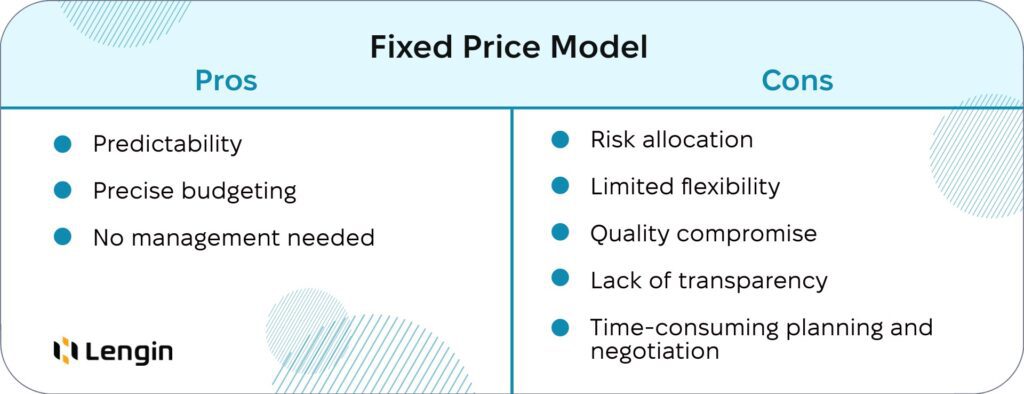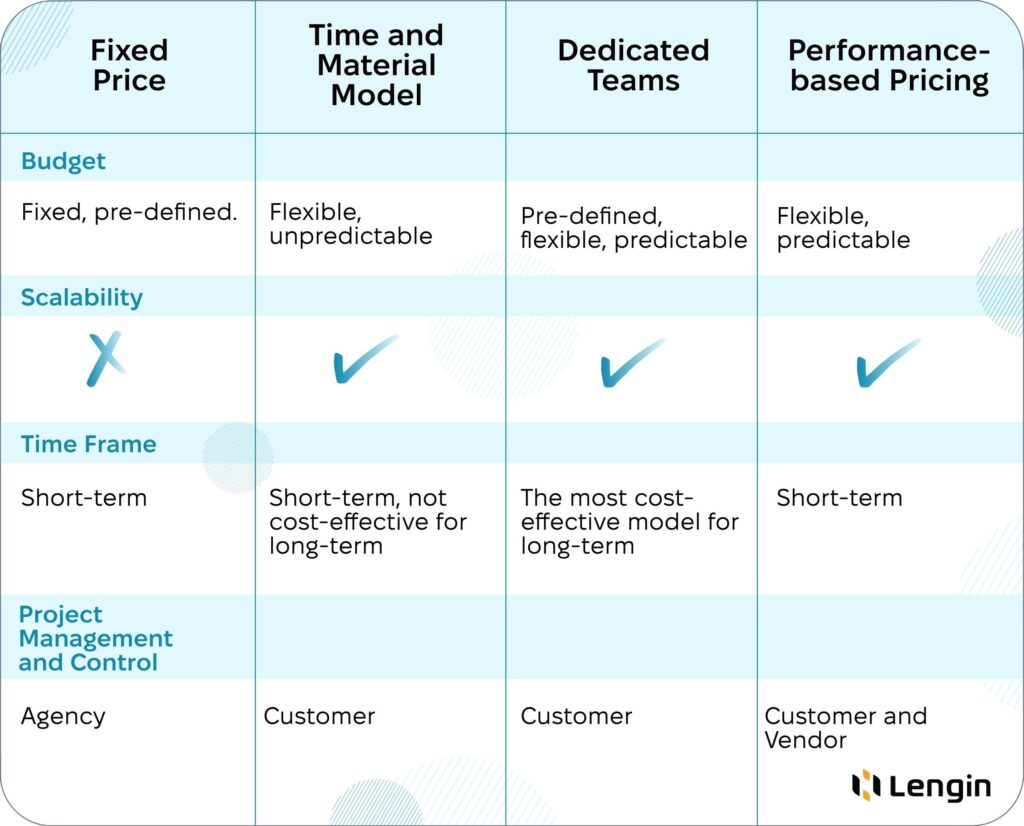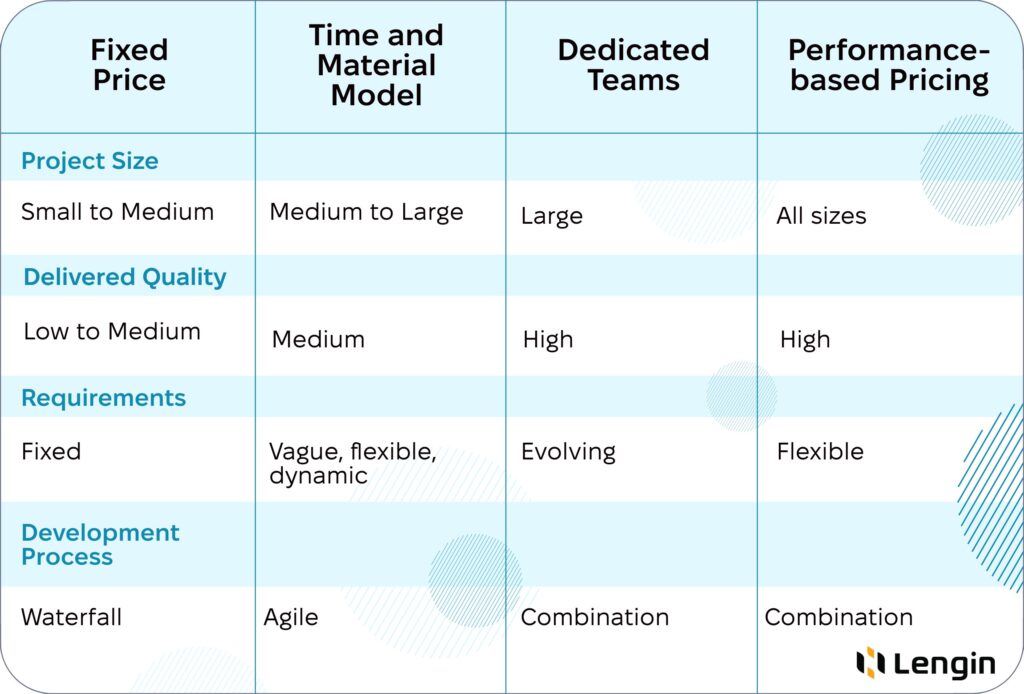The choice of pricing model determines the level of investment, commitment, and collaboration between the client and the development team. A fixed price model may seem beneficial at first but ultimately leads to several issues down the line.
That’s why considering alternatives based on your project requirements and budget can lead to better results in the future.
Table of Contents:
How Does the Fixed Price Model Work?
The fixed price is a pricing model that implies that the cost of a project or service is unchangeable, regardless of the amount of time or resources needed to complete it. The client pays the agreed-upon fixed price, and the service provider or staffing vendor bears the risk of any additional expenses during the project.
The work with a fixed price model looks like this:
- The client finds an agency and sends them specified and elaborately described requirements.
- The agency evaluates the project and provides a proposal.
- Many rounds of negotiating.
- The agency presents a project execution plan.
- The project is conducted and delivered.
- Estimating the fulfillment of all contract terms.
Pros and Cons of the Fixed Price Model
Fixed price is beneficial in terms of predictability and precise budgeting. Clients know exactly how much they must pay and what they will get.
With a clear understanding of the project’s total cost, you can plan the finances and resources more effectively. Predictability brings a sense of security that you will not be overcharged with additional fees.
Deadlines are clear, and requirements are settled. Everything that is left is waiting because all the management from the beginning to the end is placed on the shoulders of the hired service provider. They do all necessary to deliver what is agreed upon without you worrying about setbacks, lack of workforce, or project management.
Nevertheless, like everything, this pricing model is far from perfect, and its drawbacks are the main reason you should consider alternatives.

When to Use the Fixed Price Model?
The list of suitable for this pricing model is not so long and must have:
- Сlear and detailed requirements
- Well-defined scope
- Limited budget
- Set deadlines
Usually, the fixed price is used for building Minimum Viable Products and prototypes, which is why it is so popular among start-ups. Also, governmental and non-profit organizations use fixed price models because of strict accounting and limited funding.
Additionally, fixed price is a good option for short-term small projects because it’s easier to predict risks for not long periods.
It doesn’t mean you can’t use it for large and complex projects, but there are better options than the fixed price in this case.
Why Fixed Price Model with Remote Development Teams is Not the Best Option
There are five pitfalls that you should know about when considering a fixed price model.
Limited Flexibility and Risk Allocation
The expenses are predictable with a fixed price model, but life still isn’t. Market changes, new government policies, natural disasters, unpredictable global changes, and many other things are out of the agency’s control.
Force majeure will obviously impact the project, but because of limited flexibility, agencies may have to ask for time and budget extensions. It would be best if you understood that without at least minimum concessions, the agency would return the project. Even including the fine for failing to complete the agreed scope of work, they will lose less, but you will have to waste even more time searching for another executor.
Limited flexibility restrains both sides. If you need to change requirements or scope even in the slightest way, be ready for refusal or daunting negotiations.
Lack of Transparency
As a rule, the client and contractor meet only at the project’s beginning and end. The agency does all the management and can provide regular reports if they are pre-defined. However, you will not be able to check actual results.
Also, you can’t vet the staff who will work on your project because recruitment is the agency’s responsibility. Usually, service providers prefer cheaper and less skilled workers in order to save money, but you are not going to find out. The client is almost wholly blindfolded in this case.
Time-consuming Planning and Negotiations
Before signing the contract, you should expect long and exhausting negotiations. Since the terms are unchangeable, every detail must be discussed: cost, deadline, requirements.
Everything starts with discussing requirements. You may have a small project with a minimum set of features. Still, each has to be described, including step-by-step operation, visual representation with the complete design project and necessary documentation, dependencies and connections between different functions, customer journey map, and literally everything that can raise further questions.
No nice-to-have features because they are not going to be done, only must-have.
Finally, the most complicated part is bargaining about the cost. You want to set the bar as low as possible, but the service vendor wants to protect themselves from risks at least partly. Knowing your limit is awesome, but if the price is too low, do not expect the high quality. As they compromise with cost, you will have to compromise with quality.
Quality Compromise
It looks illogical to talk about low quality when all requirements are pre-defined, but every criterion is just another tick in the long list. It will be done, but how – quite another matter.
Fixed deadlines and costs reduce the right to make mistakes to zero, so developers will choose standard, basic, typical, and 100% safe methods instead of trying to find innovative solutions.
Nobody will work overtime for the sake of the success of your project. With a fixed price, you shouldn’t expect genuine dedication, only plain execution. Rushed work, cutting corners, and a lack of attention to detail are common things, so the quality suffers.
Sometimes, agencies treat your project as a side one and engage different developers who are free at that moment. Obviously, they will not look into the project and understand your needs but mindlessly put ticks against requirements.
Fortunately, these drawbacks are eliminated in alternative pricing models.
Alternative Pricing Models for Remote Development Teams
There are many other pricing models that eliminate the drawbacks of fixed price.
Time and Material Model
The time and material model is what it sounds like.
It is based on the idea that the client pays for the actual time and materials spent to complete the project. You receive invoices regularly (typically monthly) with a detailed report about the work completed during that period.
This way, the project’s progress monitoring becomes easier and more transparent. You know what you pay for and can make necessary adjustments without lengthy negotiations.
“Materials” implies any necessary software, hardware, or third-party services. The amount of resources is different for each project. Sometimes, vendors have their own licenses, using the benefits of special discounts for businesses.
Nevertheless, extreme agility may result in unexpected price overruns.
Dedicated Teams
A dedicated team is a group of specialists who work exclusively on your project and are responsible for the project’s success.
You can be sure they will deliver the project on time, within budget, and according to the required quality standards. The budget is pre-defined, but as the project grows and your needs change, the budget and team engagement evolve, too.
The best part is that a dedicated team exclusively contributes all the attention and effort to your project. They look into not only the requirements but your needs too to find the best solution. Team members often suggest their own ideas and show the initiative to improve the final result.
Also, you control the project and pay for the work according to the regular reports and invoices. Meanwhile, the team is free to make mistakes and foster innovations.
Dedicated teams are perfect for a long-term project that requires ongoing maintenance and support.
Performance-based Pricing
Performance-based pricing ties the budget to the Key Performance Indicators rather than the hours worked or materials used.
KPIs are set individually for each project and vary according to requirements, from increased website performance metrics to decreased user bounce rates — the more complex the KPIs, the higher the price.
Also, pricing can depend on certain milestones. You pay for reaching the agreed-upon results, regardless of the time and material spent. At the same time, you have control over the requirements and can change them, but you cannot affect the decisions that the agency makes to meet those requirements.
Unfortunately, this pricing model doesn’t encourage developing trusting relationships with contractors. Executors often feel pressure and do not agree to work on a long-term basis.
Comparison of Pricing Models
To choose the best pricing model for your project, you should consider not only the budget but also many other factors such as project size, time frame, requirements, preferred development process, and many others.

Time and material model, dedicated teams, and performance-based pricing eliminate the biggest drawback of the fixed price model – lack of flexibility and scalability. Also, they allow the client to control the project throughout its execution, making all the processes transparent and understandable.
Unfortunately, not all the pricing models provide you with a predictable and pre-defined budget.

Pay attention to the quality you want to get in the result. Fixed price implies compromises in this matter, but other pricing models may provide better outcomes.
Key Takeaways
- The fixed price model is perfect for predictable budgeting, which is crucial for small projects with limited funding. However, lack of flexibility and transparency, time-consuming planning and negotiations, and quality compromises are the stumbling blocks that must be addressed.
- The dedicated team is the best option for cost-effectiveness with long-term complex projects.
- Performance-based pricing applies to projects of all sizes but usually puts too much pressure on the contractor and can only be used in the short term.
- The time and material model is the most agile but may result in unexpected expenses.
- Choose a pricing model based on many criteria instead of only on the budget. Ultimately, it will benefit you more.